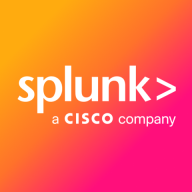

Splunk Enterprise Security and Oracle Security Monitoring and Analytics Cloud Service compete in the security solutions category. Splunk may have an edge with its robust analytics, while Oracle excels in cloud integration.
Features: Splunk Enterprise Security is known for real-time threat detection, processing large volumes of log data, and incident response automation. Oracle Security Monitoring and Analytics Cloud Service integrates robustly within Oracle's ecosystem, uses machine learning for threat detection, and offers a seamless cloud experience.
Ease of Deployment and Customer Service: Splunk offers versatile deployment and exceptional customer support, aiding in faster adoption. Oracle benefits from streamlined integration within its cloud suite, making deployment easy for existing customers.
Pricing and ROI: Splunk has a higher upfront cost but offers a strong return on investment through advanced analytics. Oracle provides a cost-effective cloud-based solution, appealing to budget-conscious users.

Oracle Security Monitoring and Analytics Cloud Service is a comprehensive solution designed to provide organizations with advanced threat detection and response capabilities. This cloud-based service leverages machine learning and artificial intelligence to analyze vast amounts of security data in real time, enabling proactive identification and mitigation of potential threats.
With Oracle Security Monitoring and Analytics Cloud Service, organizations can gain deep visibility into their entire IT infrastructure, including on-premises and cloud environments. The service collects and correlates security data from various sources, such as logs, network traffic, and endpoint telemetry, to provide a holistic view of the security posture. The product's advanced analytics capabilities of this service enable the detection of both known and unknown threats.
By applying machine learning algorithms to the collected data, Oracle Security Monitoring and Analytics Cloud Service can identify patterns and anomalies that may indicate malicious activities. This proactive approach helps organizations stay ahead of emerging threats and minimize the risk of data breaches.
In addition to threat detection, this service also offers comprehensive incident response capabilities. When a potential threat is identified, Oracle Security Monitoring and Analytics Cloud Service provides detailed alerts and actionable insights to guide security teams in their response efforts. The service also offers automated response actions, allowing organizations to quickly contain and mitigate the impact of a security incident.
The product is built on a scalable and resilient cloud infrastructure, ensuring high availability and performance. The service integrates seamlessly with other Oracle security products, such as Oracle Identity and Access Management, to provide a comprehensive security ecosystem.
Splunk Enterprise Security is widely used for security operations, including threat detection, incident response, and log monitoring. It centralizes log management, offers security analytics, and ensures compliance, enhancing the overall security posture of organizations.
Companies leverage Splunk Enterprise Security to monitor endpoints, networks, and users, detecting anomalies, brute force attacks, and unauthorized access. They use it for fraud detection, machine learning, and real-time alerts within their SOCs. The platform enhances visibility and correlates data from multiple sources to identify security threats efficiently. Key features include comprehensive dashboards, excellent reporting capabilities, robust log aggregation, and flexible data ingestion. Users appreciate its SIEM capabilities, threat intelligence, risk-based alerting, and correlation searches. Highly scalable and stable, it suits multi-cloud environments, reducing alert volumes and speeding up investigations.
What are the key features?Splunk Enterprise Security is implemented across industries like finance, healthcare, and retail. Financial institutions use it for fraud detection and compliance, while healthcare organizations leverage its capabilities to safeguard patient data. Retailers deploy it to protect customer information and ensure secure transactions.
We monitor all Security Information and Event Management (SIEM) reviews to prevent fraudulent reviews and keep review quality high. We do not post reviews by company employees or direct competitors. We validate each review for authenticity via cross-reference with LinkedIn, and personal follow-up with the reviewer when necessary.